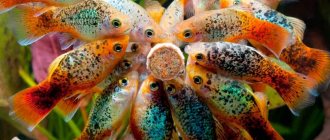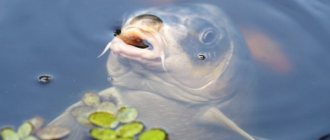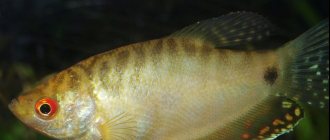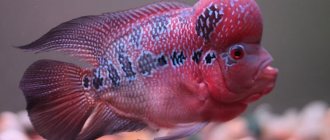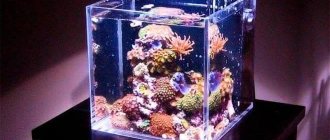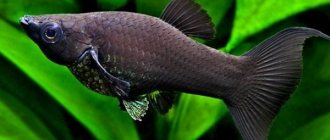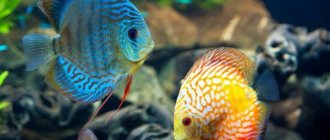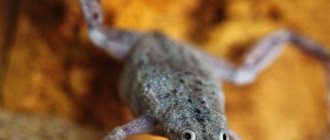Ornatus is a delicate small aquarium fish from the characin family. In the aquarium, she behaves calmly, treats decor and plants with care, and does not dig in the soil. Such residents are ideal for herbalists, where the richness and well-groomed vegetation remains in the first place. Keeping an ornatus is not difficult, but you need to know the appropriate parameters and stick to them so that the fish lives long and is healthy. Even beginners, not to mention experienced aquarists, can handle this task quite well.
Description and features
Ornatus is a fish belonging to the characin family. Its natural habitat is the Amazon and French Guiana. However, since 1933, ornathus have become one of the most popular and widespread aquarium fish.
Aquarists also know ornathus under the name “phantom”, which is due to its specific and unusual appearance. This fish has a graceful body, a non-standard almond shape, and seems almost completely transparent. In fact, its body is covered with small scales, shimmering in the light with an amazing range of different colors and shades.
The color of the ornatus depends on its subspecies:
- Black - has a gray color, which in the aquatic environment appears almost black.
- Red – has a rich scarlet color with gray spots located in the fin area.
- Phantom vulgare is the most common subspecies of Ornathus, light silver iridescent in color.
- Red-yellow is a transparent fish that shimmers in the water with yellow-red hues.
- Whitefin is one of the rarest and most exotic species. It is distinguished by its special transparency (if desired, you can see the internal organs of the fish) and a delicate pinkish body color. The fins of the fish are covered with white spots and have a bizarre shape.
Ornathus are very calm and peaceful. They adapt quite easily to new environments and changes in keeping conditions, and therefore can be recommended even to novice aquarists.
In their natural environment they lead a gregarious lifestyle, therefore, when planning to have an ornatus, you need to purchase at least 6-8 individuals, otherwise the fish will feel depressed, uncomfortable and may even die.
Kinds
In natural habitats, there are 4 types of ornathus - ordinary, pink, black phantom and red phantom. The 5th species was created by German breeders - white-finned. Let's take a closer look at each of them:
Ordinary
The body of the fish is colored pink, with a purple tint. The pelvic and anal fins are a rich pink-red color, but the caudal fin is yellow. Ornathus with yellowish sides and a silvery belly are not uncommon;
Red
The color of the fish shimmers from light pink to deep red towards the back. The abdomen is golden in color. All fins are scarlet;
Pink
The whole body is painted in a delicate pink shade with a silver tint. The fins stand out brightly against the background of the body with red and black colors;
Ornatus phantom
Black scales with light spots on the sides. Towards the caudal fin the color becomes richer. The abdomen is also dark gray. Females of this species have a characteristic color - their fins are red, and their whole body is colored brown;
Conditions of detention
Ornathus are undemanding to living conditions and do not require special care or close attention to themselves. But in order for the fish to be healthy, active and pleasing to the eye with its exotic beauty, it is worth taking care of creating an optimal habitat for it. The closer it is to natural, the better.
First of all, ornathus need to be provided with shaded and secluded places for resting, breeding, or simply shelter in case of potential danger.
The aquarium must be decorated with underwater and surface crops, green spaces, algae, various stones and driftwood. It is recommended to cover the bottom of the artificial reservoir with dry leaves, which will have to be changed at least once a week.
Despite the fact that ornathus adapt well to their environment, experts advise taking care to maintain optimal water parameters for this type of aquarium fish:
- temperature range – from +22 to +30°C;
- acidity indicators – 6-7.5 pH;
- hardness level – no more than 10°.
In addition, you should provide additional filtration and aeration of the aquarium, as well as monitor its cleanliness. It is advisable to add a special peat extract to the water, which can be purchased at any specialty store.
You need to change the water by 25% at least once a week. This simple procedure can significantly increase the life expectancy of ornathus, as well as make their color unusually bright and rich. It is necessary to clean the aquarium itself, the soil and decorative elements once every 2-3 weeks. A good filter will create the most comfortable conditions for phantom fish.
As for lighting, representatives of this species do not tolerate bright, intense lighting. Therefore, the ideal option for them would be soft and diffuse lighting, as well as the opportunity to hide in the shaded corners of an artificial pond. For safety reasons, it is better to cover the aquarium with glass or a transparent lid. The fact is that, despite their rather calm nature, sometimes ornathus become so playful and active that they simply jump out of the reservoir, as a result of which they die.
Ornathus do not have any special preferences regarding the soil, but they look most impressive against the background of a rich dark-colored soil. The optimal volume of an aquarium is about 50 liters, although this is an individual question, determined by the number of inhabitants living in the reservoir. After all, despite their elegant size, ornathus are mobile and it is important to provide them with enough free space for play and movement.
Feeding
Ornathus are quite picky eaters. The ideal food for these fish would be bloodworms, tubifex, and daphnia. Phantom fish also happily eat ready-made dry food, but you should try to diversify the diet as much as possible, periodically pampering the ornathus with fortified and nutritious live food. In addition, it is important to consider that the miniature size of the fish and its oral cavity allows it to absorb exclusively crushed food.
To maintain health and longevity, you need to add food of plant origin to the ornathus diet. This includes lettuce, spinach, duckweed, dandelion or pinnate leaves that have been pre-crushed and processed in boiling water.
It is recommended to feed ornathus in small portions, but quite often, at least 3-4 times a day.
Fish eat food only from the water surface, so when it settles to the bottom, it is important to promptly clean the soil if there are no other inhabitants living in the aquarium that absorb leftover food (for example, catfish).
Diseases
Ornathus have a strong immune system, which helps them practically not get sick. Fish are mainly susceptible to bacterial and parasitic infections; they easily tolerate medications added to the water. Diseases of this kind manifest themselves in the appearance of plaque on the body, frayed fins, lethargy, and dull eyes. The sooner treatment is started, the greater the chance of saving the fish’s life.
Prevention of diseases consists of timely and complete proper care of the aquarium: cleaning the soil, changing water. Equipment, decor and everything that goes into the aquarium must first be disinfected. Live food should only be purchased clean, from trusted places. Choose high-quality dry food. All new residents must undergo quarantine before being moved into phantoms.
Features of behavior in the aquarium
Ornathus are very interesting in their habits and behavior. First of all, these cute creatures are distinguished by their calm, friendly and peaceful disposition. They never show aggression and are friendly towards other aquarium inhabitants. They are active and mobile, but nevertheless periodically love a quiet rest in a secluded, shaded place. Therefore, ceramic houses and castles would be an ideal decor option.
Despite the fact that ornathus lead a gregarious lifestyle and in their natural environment live in groups of about 50 individuals, they tend to be solitary. These fish gather in schools for games, during spawning or in case of danger or any stress factors.
general information
A distinctive feature of the aquarium fish Ornatus is its almost transparent almond-shaped body, flattened on the side, which is covered with tiny scales of various shades. All representatives of the species are characterized by agile behavior, so in home aquariums small schools of fish actively move from one side to the other, trying to change their direction while moving.
Individuals have a two-lobed tail, a raised dorsal fin that resembles a sail, and dark spots near the gill slit. Ornathus is native to French Guiana and the lower Amazon.
Under natural conditions, fish lead a relatively peaceful lifestyle, because even males, who like to engage in territorial disputes, never attack their fellow fish, but only take a threatening pose, bending their torso and spreading their fins widely. The likelihood of fights with a fatal outcome is practically excluded.
Ornathus also do not conflict with other peaceful fish, including:
- carp thorns;
- Gurov;
- Ancistrus;
- acanthophthalmus.
By nature, Ornatus is a friendly fish. In addition, she is ready to join other flocks when dangerous situations or other animals appear in the aquarium.
Compatibility with other aquarium inhabitants
Ornathus are small and peaceful creatures. They do not pose a threat to any of their aquarium inhabitants, but they themselves may well become victims of large and predatory fish, so it is recommended to avoid such a neighborhood. It is strictly contraindicated to house phantom fish in the same artificial reservoir with cockerels, saber-toothed tetras, large species of catfish, swordtails, and chalceus.
Ornathus get along well with other representatives of the characin family, rasboras, guppies, goldfish, ancistrus, thorns, tetras and other species - also small in size and non-aggressive in terms of their behavior.
Possible diseases and maintenance problems
Nature itself has endowed ornathus with excellent health, good genetics and a strong immune system. These fish are not prone to hereditary or any other diseases characteristic of other aquarium inhabitants.
Their average lifespan in the natural environment is 5-6 years, in aquarium conditions - about 3-4, but with good care the pet’s eyelids can be extended.
The health of ornatus can be negatively affected by:
- frequent stressful situations, psycho-emotional shocks (for example, proximity to predatory fish);
- sudden change in parameters of the aquatic environment;
- improper feeding regimen, use of low-quality food;
- lack of live food and herbal supplements in the diet;
- lack of an area for relaxation and privacy in the aquarium;
- excessively bright lighting;
- pollution of the soil and the reservoir itself.
In most cases, it is enough to simply check the fluid parameters, clean the soil, the aquarium itself and decorative objects, replace the water, and the health of the ornathus will gradually be restored. This must be done in cases where the fish suddenly become lethargic and inactive, refuse food, and have lost their striking bright color. What should be especially alarming is the appearance on the body of a phantom fish of uncharacteristic specific spots that were previously absent.
If the measures taken do not give the desired result, and even more so if there are signs of traumatic injuries, you should immediately consult a veterinarian and carry out the necessary treatment.
Habitat
Endemic to the upper basin of the Orinoco River (South America), it is found in its numerous tributaries in the territory of the modern states of Colombia and Venezuela.
It lives in small rivers and streams, in the canopy of flooded areas of tropical forest, temporary lakes, as well as in the canals of main rivers. Brief information:
- Aquarium volume - from 80 liters.
- Temperature - 20–24°C
- pH value – 4.5–7.5
- Water hardness – mostly soft (1–12 dGH)
- Substrate type - any sandy
- Lighting - dim
- Brackish water - no
- Water movement - moderate to weak
- The size of the fish is about 3.5 cm.
- Food - any food
- Temperament - peaceful
- Maintain a flock of at least 8–10 individuals
Features of reproduction
Ornathus reaches sexual maturity at the age of 8 to 10 months. Under good conditions and in the absence of other inhabitants in the aquarium, the reproduction process occurs naturally, without outside interference. If you want to get good, healthy offspring, you should create the most comfortable and optimal conditions for spawning for phantom fish.
Approximately 2 weeks in advance, it is recommended to increase the amount of food and add live fortified food to the ornathus diet. During the spawning period, it is important to maintain certain parameters of the aquatic environment. The water should be soft and the temperature should be at least +28°C. To soften water, you can use specialized peat additives, which are sold in pet stores.
Determining the breeding season is simple; just observe the behavior of your pets. When mating begins, the color of males becomes especially bright and saturated, while the abdomen of females noticeably rounds. When breeding time begins, you should select one or more pairs, selecting the strongest, healthiest and most beautiful individuals, and place them in separate, pre-prepared and prepared containers.
Small aquariums with a volume of about 10 liters are suitable for these purposes, the main thing is that they have clean water and a separator mesh with algae at the bottom. It is noteworthy that feeding these fish directly during spawning is not recommended. After the eggs hatch, adults must be sent back to their usual aquarium to avoid damage to the offspring, since ornathus have no parental instincts.
It is very important to promptly clean the aquarium of dead eggs, which can be identified by their characteristic white color. To prevent infectious and bacterial processes, antiseptic drugs can be added to the water; Erythromycin is considered the most popular remedy for this purpose among aquarists.
Ornathus are spectacular and very beautiful graceful fish that decorate any aquarium. They are easy to care for, have interesting habits, are peaceful and do not require special attention.
Breeding
Breeding phantoms is not difficult. But you should be patient and attentive, and be sure to follow the following instructions.
- Prepare a separate aquarium with a capacity of 20 liters or more, with a water level of about 15 cm.
- Place a separator net or a small number of plants with small leaves at the bottom.
- Choose water so that it is a couple of degrees warmer, softer and more acidic than in the main aquarium.
- Within two weeks, the fish are settled and fed generously.
- The courtship process will last 3 days. Then the female spawns from 100 to 400 eggs.
- After completion, the fish are returned to the main house. The aquarium with caviar is slightly shaded, and weak aeration is provided.
After 48 hours, tiny fish will appear and will feed on the yolk sac for 3-4 days. Afterwards they are fed every 3 hours.

